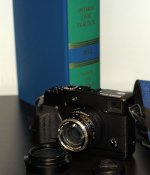The Xpro1 sensor is not well-optimized for short focal length RF lenses, nor are the EVF and focusing aids really up to the task. Same goes for the Micro-FourThirds bodies and the NEX 7 sensor (it does have focus peaking aids). The NEX 5n performs better than the NEX 7 with short focal lengths.
The best non-Leica body for M-Mount RF lenses in current production is the Ricoh GXR fitted with the A12 Camera Mount..
🙂
I would tend to agree about the gxr w/ m mount having used legacy lenses on gxr, Nex and Fuji xp1 cameras. The gxr is the best user experience.
1- multi magnification capability
2- two types of focus peaking
3- works well with even very wide rf lenses
4- supports custom lens settings including distortion adjustments
On the gxr if I have mag assist active, a half press takes me out of it for full frame recomposure of the shot and focus peaking lets me get a good idea of what going on with other area of the frame. After I take the shot, it automatically goes back to mag assist mode unless I keep it half pressed. It took me a while to get used to it, but once u do, it s a great process.
The only down side is per shot write speed s a bit slower....
Where as Fuji until this latest 2.0 fw update only had 10x mag assistance but now also has 3x which will help with lenses from 50 on up... Still no mention of focus peaking. With the Fuji m Adapter supports custom lens setting.
On the Fuji, lenses from 40 on up, no one complains about any issues. From 35 on down, it is a different story. Some lenses are fine others are not. Most complaints are related to corner smearing since most other issues seem to be correctable with SW. This is really a cases of YMMV depending on lens and how picky u are.
As i said in an earlier post, I mainly use legacy lenses right now to fill in for missing lenses in the lineup... By end of next year, that will all be eliminated. The Fuji lenses are really very good.
Gary
Ps- I wish Ricoh would release a a16 m module.


